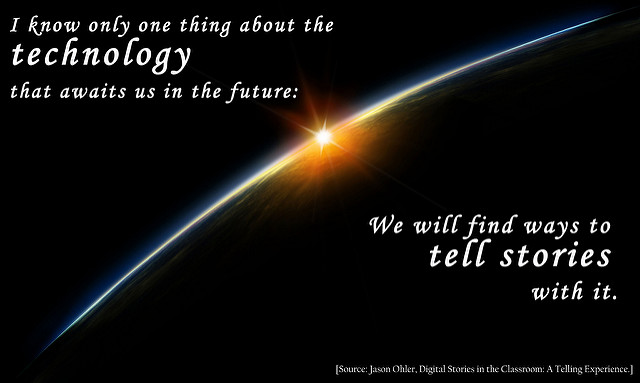February 24, 2022
 |
A Powerful Digital Story https://vimeo.com/110722454 |
- Sign in and stow your phones out of sight. Log into a Chromebook and complete the WYAW activities.
- KWL Veggie Tables: Digital Storytelling? What do you think you know? Tell us on Whiteboard.fi (https://whiteboard.fi/) REMINDER: Do this by tables - collaboration, creativity, critical thinking, communication (4Cs!)
- Veggie Tables Round 2: Choose three or more words or phrases you can think of to describe the intro story from Katie Cahn. What do you notice about the visuals and narration? How much music is used and for what purposes? Divide the board in two and on one side list 2-3 positives about the creative aspect of the story and on the other side, 2-3 positives about the technical aspects.
- A little history of digital storytelling from StoryCenter formerly known as The Center for Digital Storytelling (:01 to 5:16) Let's hear from Joe Lambert about some groovy artists and community activists wanting to tell their story to the world and a powerful example of the first "official" digital story that we'll discuss. What is your response? NOTE: This is storytelling by adult makers/tellers.
- Joe Lambert from StoryCenter (formerly the Center for Digital Storytelling) developed Seven Elements of a Digital Story (available in PDF format) This is also seen in the Bull and Kajder article from this week's reading. Lambert updated his book in 2010, (Digital Storytelling Cookbook, 2003; Digital Storytelling Cookbook, 2010). What do these elements look like and how might you assess digital stories using this framework as a guide?

Photo by Silvia Rosenthal Tolisano
- Story break: Let's view some examples of digital stories from past classes. Format: Two compliments.
- Amber H. https://vimeo.com/298544365
- Brittany C. https://vimeo.com/369981166
- Cydney W. https://vimeo.com/261568848
- Sabrina E. https://vimeo.com/209325647
- WeVideo Studio Time. Log into WeVideo https://www.wevideo.com/ with your class gmail account!
- Title and Credits
- Using the stock media in WeVideo (paid subscription)
- Adding images and video and editing
- Recording narration and adjusting volume
- Adding music and adjusting volume
- Adding titles over an image or video
- Finishing and getting the published link
BE THINKING.....
Start thinking about a personal story you want to tell. It can be about anything you wish. There are some "must haves" including visuals, narration, duration (between 1:30 and 4:00 minutes), and a title and credits. You can include also - video, sound effects, music, and animations. Want to try out chroma key (green screen) - go for it! THIS IS ON ANY TOPIC YOU WISH.
DIGITAL STORYTELLING ASSIGNMENT: Your Personal Digital Story:
This is an open-ended story that can be about any topic you wish. This assignment has TWO parts and ALL will be submitted in Canvas:
- A link to your personal digital story from WeVideo once it has been "Finished" and published. DON'T link to your editing/timeline environment. You may also use Vimeo if that is your preference but is not required. You will add the link to your reflection template.
- Your storyboard or evidence of planning either scanned or photographed as a digital image (if you wrote on a blank template) OR a Word file if you typed on the template. Storyboard templates are available in Word format in Canvas.
- The personal digital story reflection using the designated word template for in Canvas under Assignments
(filename: "personal_digital_story_reflection_2021-2022.docx").
- You can see all the requirements for this assignment and how you will be assessed by viewing the rubric in Canvas or from our web agenda.
Choice Assignment Option: Field-Based Digital Story with A Student
View the project overview: This will help you explain to your CE what the project is all about. When discussing this with your CE, set some tentative dates for when you can work with your one student to create the story. The project overview handout gives an summaryof the process. Share this with your CE if you think it would be helpful.
Additional resource: If you wish to show your student sample stories, you may use these:
| Kindergartner | Fifth Grader | Middle School |
Pretty soon, start making arrangements to meet with the child to talk about the story he/she might like to tell and how to illustrate it - with his/her own drawings or photos, with copyright free (CC0) photos or images found (with your help) on the internet. See here for ideas and details..... The reflection form for this project is available in Canvas.
- You will need to get the parental permission form (Release) signed by the parent and this is also available in Canvas.
- The story must be created by a child (not someone else's story) and creative freedom from the student must be apparent.
- You'll want to give yourself enough time to work on it as it may take more than one session. If you're working with young children or learners with disabilities who struggle with focus, you may need to schedule a few short sessions rather than one long one.
- Keep an eye on the technical and don't get frustrated if you encounter snags.
RESOURCES O' THE DAY:
THE Source for Digital Storytelling: http://www.storycenter.org/
THE Top Academic Source for Digital Storytelling: http://digitalstorytelling.coe.uh.edu/
More about StoryCenter (formerly the Center for Digital Storytelling) http://www.storycenter.org/press/
IF YOU PLAN TO CHOOSE THE DIGITAL STORY WITH ONE CHILD:
Talk with your clinical educator about the digital storytelling project and work out logistics of where and when you'll work with the student to help them create a digital story. YOU WILL NEED TO GET A RELEASE SIGNED BY THE CHILD'S PARENT/CAREGIVER.
